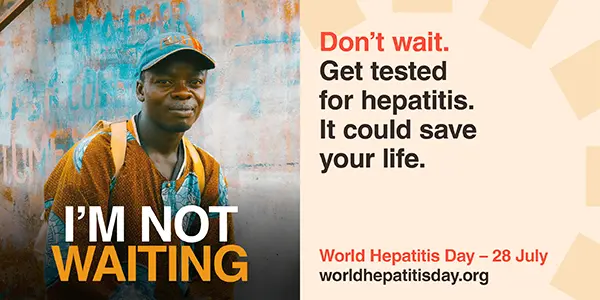In honor of World Hepatitis Day (July 28), we come together to discuss the global issue of hepatitis and its impact on millions of lives.
In this article, we will explore the newest developments in prevention, treatment, and awareness efforts while also considering the challenges we face in our mission to eliminate this silent but powerful enemy.
Join us as we increase awareness and empathy, and call for action toward a world free from hepatitis!

*Image taken from World Hepatitis Day
What is World Hepatitis Day?
World Hepatitis Day, observed annually on July 28th, is a global initiative dedicated to raising awareness about viral hepatitis.
It serves as a platform to educate the public, advocate for policy changes, and promote actions to help prevent and eliminate hepatitis.
The significance of July 28th lies in it being the birthday of Dr. Baruch Blumberg, who discovered the hepatitis B virus in 1967 and subsequently developed the first hepatitis B vaccine.
This day honors his groundbreaking contributions to the field of viral hepatitis research.
The main goal of World Hepatitis Day is to shed light on the global burden of viral hepatitis and highlight the need for action.
More than 350 million people worldwide are living with chronic hepatitis B or C, which can lead to severe liver diseases such as cirrhosis and liver cancer.
Despite this alarming statistic, hepatitis often goes undiagnosed and untreated due to a lack of awareness and limited access to healthcare services.
World Hepatitis Day Initiatives and Events
Every year on July 28th, World Hepatitis Day raises awareness and encourages action against viral hepatitis.
Various entities, such as organizations, government bodies, healthcare professionals, and communities, collaborate to make a significant impact.
These efforts include educational campaigns, testing and screening initiatives, vaccination drives, seminars, conferences, and community outreach programs.
To engage the public and spread awareness about liver health and the prevention, testing, and treatment of hepatitis, concerts, rallies, and pop-up events are also organized.
Together, people can tackle the issues associated with hepatitis, including discrimination and stigma, and work towards the goal of eliminating viral hepatitis as a public health threat by 2030.
The aim is to educate and empower individuals with information about testing, vaccination, and policies to eliminate the disease.
World Hepatitis Day offers various events and activities to promote collaboration, education, and action toward a world free from the burden of hepatitis.
Understanding Hepatitis: Types, Causes, and Risk Factors
Hepatitis is a group of viral infections primarily affecting the liver, causing inflammation and potentially damaging this vital organ.
There are different types of hepatitis viruses, namely A, B, C, D, and E, each with distinct characteristics and modes of transmission.
Hepatitis can be acute, lasting for a short period, or chronic, persisting for six months or more.
The symptoms of hepatitis may vary from mild fatigue and loss of appetite to more severe manifestations such as jaundice (yellowing of the skin and eyes), abdominal pain, and liver failure.
Hepatitis can spread through contact with infected blood or bodily fluids, contaminated food or water, and from mother to child during childbirth.
The prevention and treatment of hepatitis vary depending on the specific type and stage of the infection, with vaccinations available for hepatitis A and B.
Raising awareness about the disease, promoting early diagnosis, and implementing preventive measures are crucial steps in combating the global burden of hepatitis.
Hepatitis Types, Symptoms, and Transmission
| Type | Description | Symptoms | Transmission |
|---|---|---|---|
| Hepatitis A | Hepatitis A is a highly contagious liver infection caused by the hepatitis A virus (HAV). It is usually transmitted through contaminated food and water or close contact with an infected person. | – Fatigue – Nausea and vomiting – Abdominal pain – Loss of appetite – Jaundice (yellowing of skin and eyes) |
– Consumption of contaminated food or water – Close contact with an infected person |
| Hepatitis B | Hepatitis B is a viral infection that affects the liver. It can be either acute or chronic and is transmitted through exposure to infected blood or other body fluids. | – Fever – Fatigue – Abdominal pain – Dark urine – Jaundice |
– Contact with infected blood (e.g., through sharing needles or syringes) – Unprotected sexual contact with an infected person – From mother to child during childbirth |
| Hepatitis C | Hepatitis C is a bloodborne virus that primarily affects the liver. Left untreated can lead to chronic infection, cirrhosis, and even liver cancer. | – Fever – Fatigue – Loss of appetite – Nausea – Joint pain |
– Contact with infected blood (e.g., through sharing needles or syringes) – From mother to child during childbirth (less common) |
| Hepatitis D | Hepatitis D, or “delta hepatitis,” is a severe liver disease caused by the hepatitis D virus (HDV). It can only infect people who are already infected with hepatitis B. | – Similar symptoms to hepatitis B – Can lead to more severe liver damage than hepatitis B alone |
– Co-infection with hepatitis B virus – Superinfection in people with chronic hepatitis B |
| Hepatitis E | Hepatitis E is a waterborne virus that can cause acute liver disease, particularly in areas with poor sanitation and inadequate access to clean drinking water. | – Similar symptoms to hepatitis A – May be more severe in pregnant women |
– Consumption of contaminated water – Can be transmitted through undercooked or raw meat from infected animals |
The Global Burden of Hepatitis
Hepatitis poses a significant public health challenge globally, affecting millions of people.
Viral hepatitis, especially hepatitis B and C, is a major cause of liver-related illnesses and deaths.
According to the World Health Organization (WHO), approximately 290 million people suffer from chronic hepatitis B, and around 70 million people have chronic hepatitis C.1
These infections can lead to severe complications such as liver cancer, liver failure, and liver cirrhosis.
Hepatitis affects health and has significant economic consequences, including healthcare expenses and lost productivity.
Low- and middle-income countries bear a higher burden, with limited access to prevention, testing, and treatment.2
Eliminating hepatitis as a public health threat requires a joint effort from governments, healthcare systems, and communities to increase awareness, improve access to healthcare services, and implement effective prevention and control strategies.
The Progress So Far: Achievements and Challenges
The battle against hepatitis has seen both impressive accomplishments and ongoing obstacles.
Significant progress has raised awareness about the different types of hepatitis and how it spreads.
Vaccination campaigns have successfully reduced the burden of hepatitis A and B in many areas.
The medical field has made strides in research, resulting in more effective treatments for hepatitis C, which improves patient outcomes.
Public health initiatives have also led to improved screening and early detection of hepatitis cases, allowing for timely interventions.
However, the challenges persist, especially in resource-limited settings, where access to testing, treatment, and prevention remains inadequate.
Stigma and discrimination toward those afflicted by hepatitis continue to impede efforts to reach vulnerable populations.
Moreover, the high cost of medications can be a barrier to accessing treatment, and in some areas, the lack of funding for hepatitis programs poses a significant challenge.
To continue making progress, it is crucial for governments, healthcare organizations, and international partners to work together and invest in comprehensive strategies that tackle the underlying causes of hepatitis, enhance healthcare infrastructure, and provide fair access to prevention and treatment services for all groups.
PROMISING TREATMENTS FOR HEPATITIS C
Thanks to new treatments and medications, hepatitis C can now be cured.
Direct-acting antiviral (DAA) drugs have been developed that are highly effective, with cure rates of over 95%.3
These drugs work by targeting specific components of the hepatitis C virus, preventing it from replicating and leading to its clearance from the body.
DAAs are also well-tolerated and have fewer side effects than older treatments.
Additionally, these new medications can be taken for shorter periods, usually around 8 to 12 weeks, which is more convenient for patients.
Generic versions of these life-saving drugs are now available, making hepatitis C treatment more affordable and accessible in many countries.
Ongoing research is working to improve these treatments even further, bringing us closer to the goal of eradicating hepatitis C as a public health threat.

Empowering Individuals: Hepatitis Prevention and Testing
It’s important to empower people through initiatives aimed at preventing and testing for hepatitis to combat this viral disease globally.
Education and awareness campaigns are crucial in promoting behaviors that can reduce the risk of hepatitis transmission, such as practicing safe sex, avoiding sharing needles and personal hygiene items, and adopting proper food and water hygiene practices.
Vaccination against hepatitis A and B is one of the most effective preventive measures, and ensuring access to vaccines is essential.
Regular testing and early diagnosis are also important in identifying infections early on, as this allows for timely interventions and reduces the risk of complications.
Encouraging individuals to get tested, particularly those with risk factors, and providing accessible testing facilities are key components in the fight to eliminate hepatitis.
By giving people knowledge and access to preventive measures and testing services, we can make significant progress in reducing the spread of hepatitis and safeguarding the health of communities across the globe.
Improving Access to Hepatitis Treatment and Care
Improving access to treatment and care for hepatitis is crucial in reducing the global burden of this disease.
A critical step towards achieving this is to ensure that effective medication, such as direct-acting antivirals (DAAs), are available and affordable to all.
Governments and international organizations can be pivotal in negotiating with pharmaceutical companies to lower drug prices and expand access to generic versions of essential medications.
Besides, healthcare systems can be strengthened, and healthcare professionals can be trained on the latest treatment guidelines to enhance the delivery of hepatitis care.
Targeted outreach efforts and community-based interventions can also help identify individuals needing testing and treatment, particularly in marginalized populations.
Telemedicine and mobile health initiatives offer innovative solutions to reach remote areas and underserved communities.
By prioritizing equitable access to treatment and care, we can significantly improve outcomes for people living with hepatitis and move closer to achieving the global goal of hepatitis elimination.
The Role of Governments and NGOs
Governments and non-governmental organizations (NGOs) are pivotal in the fight against hepatitis.
Governments are central in formulating and implementing comprehensive national strategies for hepatitis prevention, testing, and treatment.
They are responsible for allocating resources, strengthening healthcare infrastructure, and facilitating access to affordable medications and vaccines.
Additionally, governments can initiate awareness campaigns and support targeted interventions to reach vulnerable populations.
NGOs, conversely, complement government efforts by advocating for hepatitis control, raising awareness, and providing support services to affected individuals.
They play a crucial role in community engagement, fostering partnerships with healthcare providers and advocating for policy changes to eliminate barriers to hepatitis care.
To effectively combat hepatitis and achieve the goal of a world free from this preventable disease, it is crucial for governments and NGOs to work together through multi-faceted approaches.
Their collaboration is essential in this fight.
Breaking the Stigma: Advocating for Hepatitis Patients
It is crucial to break the stigma surrounding hepatitis so that patients can receive the care and support they need.
Stigmatization and discrimination can cause people living with hepatitis to feel isolated and hesitant to seek diagnosis, treatment, and support.
Advocacy efforts are essential in educating the public about the realities of hepatitis, dispelling myths, and promoting empathy and understanding.
By sharing personal stories and experiences, advocates can help people understand the impact of hepatitis and foster compassion.
Healthcare providers, NGOs, and governments can collaborate on stigma reduction programs to create safe spaces for patients to access care without fear of judgment.
Empowering hepatitis patients with knowledge, support, and a sense of belonging can lead to better treatment adherence, improved mental health, and ultimately better health outcomes for individuals and the broader community.

The Path Forward: Committing to Hepatitis Elimination
To eradicate hepatitis, it is important to remain dedicated to our efforts to combat it.
Our focus should be on prevention, testing, treatment, and creating public awareness.
Governments need to invest in strong healthcare systems that provide affordable medication, vaccinations, and quality care to all individuals.
Collaboration between governments, NGOs, and healthcare providers is crucial to reach underserved populations and implement targeted interventions.
We should advocate for policy changes, eliminate barriers to care, and create a non-judgmental environment that empowers individuals to take control of their health.
World Hepatitis Day is a significant occasion that plays a vital role in fighting hepatitis.
It is encouraging to see how it empowers communities by spreading awareness, advocating for better treatment access, and eliminating the stigma around the disease.
Let us work together with dedication to eliminate the silent threat of hepatitis worldwide.
Each step we take brings us closer to a future free from this disease.
If you or a loved one is struggling with addiction, don’t hesitate to contact us at Cornerstone Healing Center in Scottsdale, AZ. Our trauma-based treatment center is dedicated to helping you heal from the inside out for long-lasting recovery!
SOURCES
[1] Global Viral Hepatitis: Millions of People are Affected
[2] Surveillance of antimicrobial resistance in low- and middle-income countries: a scattered picture
[3] Hepatitis C in a New Era: A Review of Current Therapies
Published: 7/28/2023
Contributor: Julie Miller






